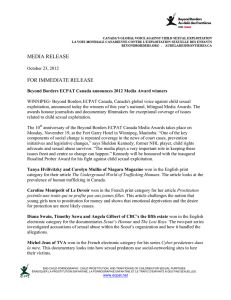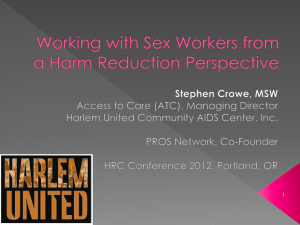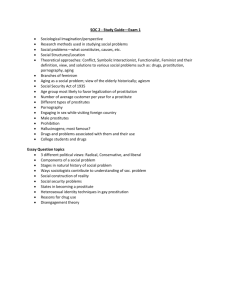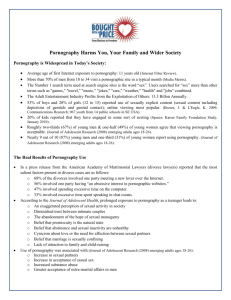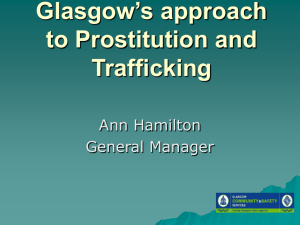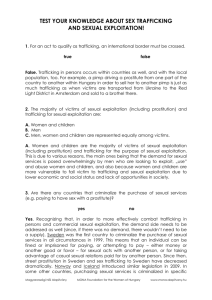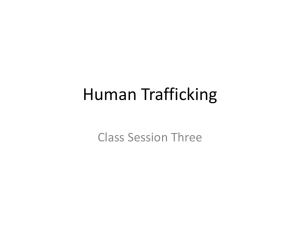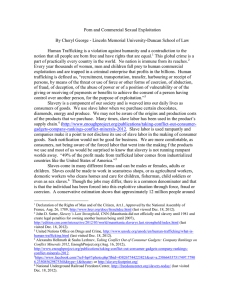Dia 1
advertisement
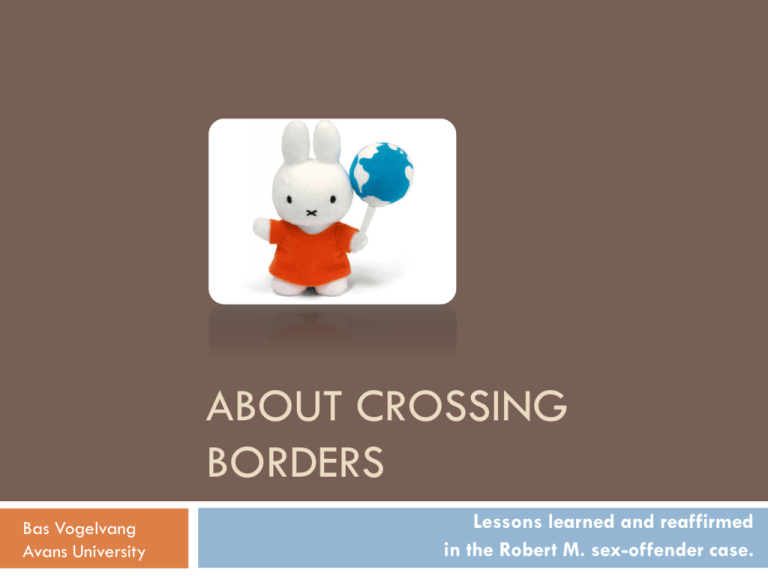
ABOUT CROSSING BORDERS Bas Vogelvang Avans University Lessons learned and reaffirmed in the Robert M. sex-offender case. 1. Internationally active 2. Very young children 1. Less vulnerable for detection and trial Very young children 2. Victim’s age and abuser relationship: Victim’s age 0-5 (10%) 6-11 (58%) 12-17 (32%) Family Other member acquaintance 49% 48% 42% 53% 24% 66% Stranger 3% 5% 10% Barriers: 1) arrange availability 2) use force 3) avoid detection 4) minimize guilt Snyder, 2000 3. Offender age 4. Offender type 3. Relatively young: Age <21 21-30 31-40 41-50 51-60 >60 % 3% 10% 24% 37% 19% 6% WODC 2004 4. ‘Lover’ and predator: Strong pedosexual preoccupation Frequent child contact ‘lover’, often homosexual Incidental / infrequent child contact Weak pedosexual preoccupation incest pedosexual predator opportunistic predator Knight & Prentky, 1990 5. Internet sharing 6. Out of sight 5. Not very common, increased his vulnerabilility Linked with organized crime 6. Robert M. profited from a lack of transnational legislation and co-operation cross-national pedosexual child abuse is only one dimension of cross-national child sexual exploitation: Child Sex Tourism Child Trafficking Child Pornography Child Cybercrime Associated ‘demand and market related’ crime Child sex tourism destination countries Vogelvang, Wolthuis & van den Braak 2004 Child sex tourism: offender types ECPAT 2010 Situational child sex offender Takes the opportunities presented to him to use a minor as sex object Preferential child sex tourist Actively travels and seeks out minors for sexual contact Pedosexuals as subgroup, sometimes working together Both types of offenders create a local demand in receiving countries Creation of a sex tourist market sexual desires and self-created opportunities of sex-offenders poverty and underdevelopment, lack of education, urge for survival political and social disruption and the existence of organized crime lack of or insufficient national and extraterritorial laws, combined with corruption and lack of enforcement legal tourist activity (hotels, bars, transport) also profits from the sex tourist market cultural factors, most importantly opinions about girls and females and sexuality of minors, often religiously motivated family circumstances family pressure sexual offending within the family broken families and runaway children / orphans / adoption child trafficking child labour Example: Baltic states, 2000 Downfall of communism: no immediate alternative social structure Prostitution amongst street children Russia and Scandinavia as sending countries Linked with organized crime and trafficking to both Western Europe and Baltic states Child trafficking in one year 1.2 million children trafficked worldwide (UN). Europe: 200,000 individuals trafficked annually from eastern Europe Significant proportion being children being forced into child labour, prostitution and crime. Terre des Hommes: 6,000 children between the ages of 12 and 16, with more than 650 being forced to work as sex slaves in Italy. Increase of abuse of adoption procedures Internet allows for finding and abusing children outside holiday resorts change in trafficking destinations Child pornography and Cybercrime Child pornography: Production increasingly linked to child sex tourism Consequently linked to trafficking of children to produce new pornographic material Cybercrime: Linked with blackmail, child pornography, child trafficking and child sex tourism Increase of online solicitation of children for self-generated webcam child abuse material ECPAT: Link equivalent legislation in all jurisdictions with integrated partnerships with the private sector, NGOs, education specialists and other stakeholders Example: ROBERT: Risk taking Online Behaviour Empowerment through Research and Training Internet and Online Service Providers need to install reporting mechanisms Response is slow but steady Pioneering work of NGOs and intergovernmental organizations, such as the United Nations Followed by governments by increasing number of international conventions and treaties. World Congresses Against Commercial Sexual Exploitation (Stockholm 1996, Yokohama in 2001). Europe: Optional Protocol to the Convention on the Rights of the Child on the sale of children, child prostitution and child pornography. Adopted 2000. Council of Europe Convention on the Protection of Children against Sexual Exploitation and Sexual Abuse Council of Europe Convention on Cybercrime Declaration of the Committee of Ministers on protecting the dignity, security and privacy of children on the Internet > 30 countries with extraterritorial laws that allow the prosecution of their nationals for crimes committed abroad, regardless of whether the offense is punishable in the country where it occurred. Heroes Children at Risk in Baltic Sea Region CRIN - Child Rights Information Network ENOC - The European Network of Ombudsmen ISPCAN - International Society for Prevention of Child Abuse and Neglect SEECRAN - South East European Child Rights Action Network ECPAT - End Child Prostitution, Child Pornography and Trafficking of Children for Sexual Purposes Save The Children The Separated Children in Europe Programme ICMEC - The International Centre for Missing & Exploited Children EURONET - The European Children's Network EveryChild Operation Predator Operation Rescue / Europol Recommendations: improve … Prevention and treatment of (repeat) victims in receiving countries Offender treatment availability and efforts for social inclusion combined with control and supervision, e.g. Circles of Support and Accountability National and extraterritorial laws for sex offenders Self-regulation and participation in legislation of (inter-)national organizations: international / global trade companies, tourist industries and national tourism departments, national police and justice departments internet providers Role of NGOs combating child sexual abuse: Help them to ... combine their efforts for collecting information and sharing it with (inter-) national organizations launch more worldwide awareness campaigns and local support programs Hiring protocols and integrity screening of professionals & volunteers working with children Assessment and intervention competence of police officers and child protection workers It is the spirit and not the form of law that keeps justice alive Earl Warren contact : bo.vogelvang@avans.nl
